
The bleeding heart flower is a beautiful plant known for its unique and eye-catching appearance.
As you learn more about this fascinating flower, you’ll discover that it holds a variety of meanings and symbolism in different cultures.
In the language of flowers, the bleeding heart often symbolizes passionate love and romance. Its pink and white blossoms may represent unrequited love or a broken heart.
Beyond romantic connotations, the flower is sometimes associated with the need to express your emotions openly and embrace your true self.
With its rich symbolism and striking appearance, the bleeding heart flower adds beauty to its surroundings and inspires compelling stories and emotions in all who encounter it.
As you learn more about this extraordinary flower, your meanings resonate with your experiences and emotions.
In this article, we'll cover
- 1. Bleeding Heart Flower Basics
- 2. Bleeding Heart Flower Care
- 3. Bleeding Heart Flower Symbolism
- 4. What Is The Spiritual Meaning Of Bleeding Heart Flower?
- 5. Common Colors of Bleeding Heart and Their Meaning
- 6. Uses and Benefits of Bleeding Heart Flowers
- 7. Interesting Facts about Bleeding Heart Flower
- 8. What Occasions Are Bleeding Heart Flowers Commonly Gifted?
1. Bleeding Heart Flower Basics
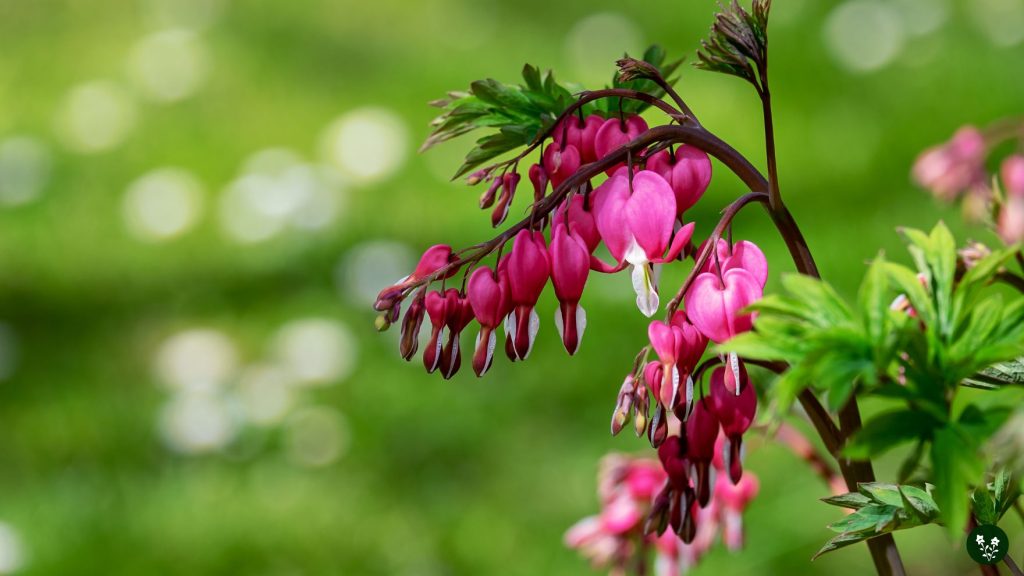
The bleeding heart flower is a beautiful and unique plant known for its distinct heart-shaped flowers.
Let’s learn more about its botanical name, physical characteristics, and the regions where it thrives.
Botanical Name and Classification
The bleeding heart flower is scientifically known as Lamprocapnos spectabilis, although it was previously classified under the name Dicentra spectabilis.
It belongs to the family Papaveraceae.
Physical Characteristics
When it comes to physical traits, the bleeding heart flower is easily recognizable due to its unique features:
- Bloom Time: The flowers typically bloom in late spring and can last until early summer.
- Colors: The flowers come in shades of pink, red, and white. The most common variety has pink petals with a protruding white tip resembling a drop, hence the name ‘bleeding heart’.
- Asian Bleeding Heart: This term refers to the plant’s origin in Asia, as it is primarily native to eastern Asia, including China, Korea, and Japan.
Regions and Habitats
Given its origin in Asia, the bleeding heart flower is well adapted to grow in temperate regions.
However, it has also been successfully cultivated in other environments, including North America and Europe.
This plant prefers moist, well-drained soils and partial shade for optimal growth.
It typically thrives in woodland gardens or shaded borders, offering a stunning visual effect that is both delicate and captivating.
2. Bleeding Heart Flower Care
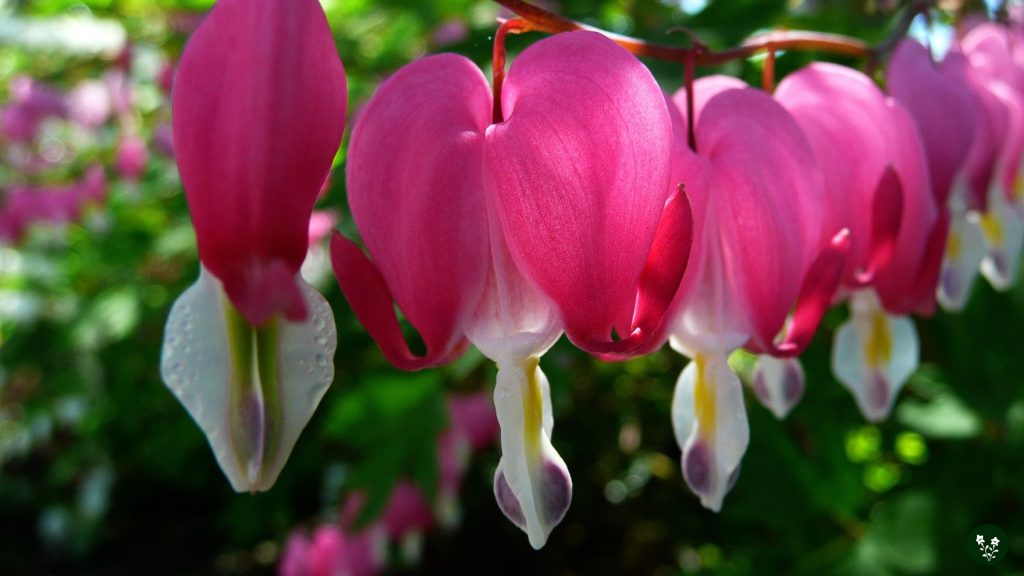
Caring for bleeding heart plants involves providing the right environment and specific maintenance.
You can help your bleeding heart plants flourish and showcase their beautiful, symbolic blossoms by ensuring proper care.
First and foremost, select an ideal location for your plants. Bleeding hearts prefer shady, cool areas reminiscent of woodland settings.
Please ensure the soil in which you plant them in moist, fertile, and humus-rich, with a neutral or slightly alkaline pH level.
Add a time-release fertilizer to the surrounding soil to promote new growth when fresh shoots appear in spring.
Supplement with additional compost to nourish the plants and maintain soil health.
Watering is an essential aspect of bleeding heart flower care. These plants require consistent moisture, so monitor the soil closely and water regularly to prevent it from drying out.
While the essence of the bleeding heart plant is known for its romantic symbolism, it’s important to be aware of its potential hazards.
Bleeding heart plants contain isoquinoline alkaloids, which can be toxic to humans and animals if ingested.
Ensure you and your loved ones enjoy this beautiful plant safely by keeping it away from pets and children.
By following these simple care guidelines, you can help your bleeding heart plants thrive and display their stunning, heart-shaped flowers with such deep meaning.
3. Bleeding Heart Flower Symbolism

Bleeding heart flowers carry different meanings and symbolisms, making them popular in gardens, bouquets, and poetry.
We will discuss the etymological meaning and cultural significance of the bleeding heart flower.
Etymological Meaning
The bleeding heart flower is often associated with love, passion, and romance. This connection is evident in the flower’s unique shape, which resembles a heart with a drop of blood.
This symbolism represents the unconditional love between two people and their emotional connection.
Interestingly, the bleeding heart flower also conveys themes of sensitivity, rejected love, and emotionality.
This symbolism highlights the importance of expressing one’s emotions and encourages you to open up.
Cultural Significance
The bleeding heart flower holds various meanings in different cultures, highlighting its versatility and broad appeal.
In some Eastern cultures, the flower is traditionally associated with spurned or rejected love.
This interpretation emphasizes the need for compassionate understanding, even in the face of unrequited feelings.
The bleeding heart flower is linked to emotions and sensitivity in Japanese culture.
This significance serves as a reminder to value our emotional well-being and to express our feelings with loved ones openly.
Lastly, the bleeding heart flower ties to Greek mythology, which symbolizes the ability to bridge the connection between life and death.
This ethereal connection showcases the flower’s spiritual nature, reminding us of the transcendent nature of love, surpassing the boundaries of the physical world.
The bleeding heart flower’s symbolism encompasses love, passion, sensitivity, and emotional connections, making it a remarkable symbol in various cultures worldwide.
4. What Is The Spiritual Meaning Of Bleeding Heart Flower?
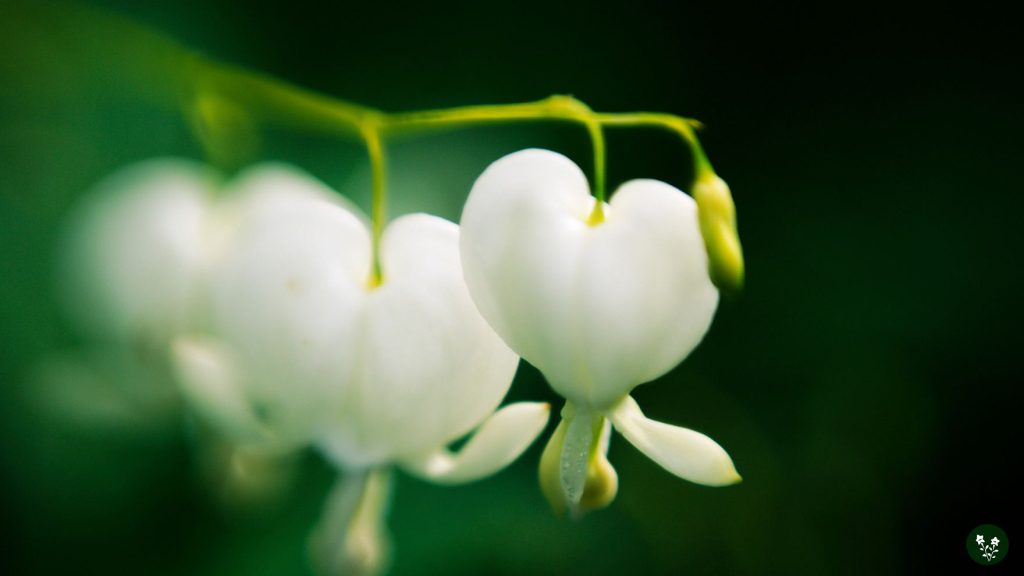
The spiritual significance of the Bleeding Heart flower lies in its extraordinary appearance and representation of distinct emotions.
Its unique shape reflects an essence of deep, passionate love, and it’s often associated with feelings of compassion, pureness, and the sharing of emotions.
The flower’s symbolism is multifaceted, depending on the context and culture in which it’s interpreted.
The Bleeding Heart flower often represents the depths of romantic love between two partners. It’s a visual reminder of the power of unconditional love and the strength to overcome heartache together.
Another layer of meaning in the spiritual world is freely expressing your emotions.
The Bleeding Heart flower encourages you to be transparent about your feelings and remain true to yourself in times of joy and sadness.
Authentic communication is essential for fostering healthy relationships and personal growth.
In some spiritual circles, the Bleeding Heart flower also denotes compassion, empathy, and understanding towards others.
Embracing these qualities helps to establish strong connections and nurture bonds with the people in your life.
5. Common Colors of Bleeding Heart and Their Meaning
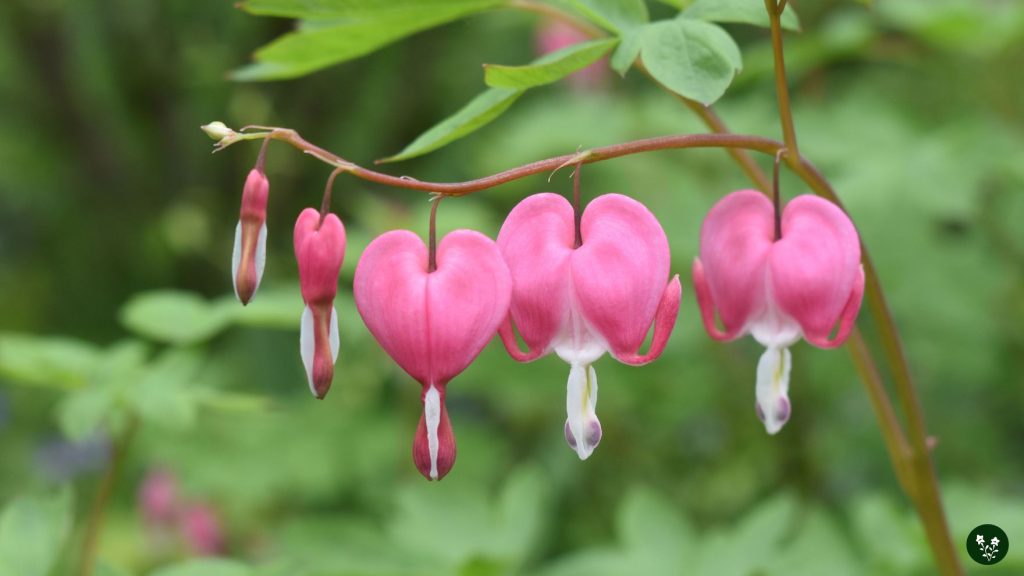
Bleeding heart flowers come in various colors, each with its symbolism.
Understanding the meaning behind each color can help you appreciate the beauty of these flowers even more.
The most common colors are red, pink, white, and, occasionally, shades of blue and purple.
Pink, bleeding heart flowers represent undying and unrequited love.
These blooms convey a strong sense of romantic passion and can be used to express your affection for somebody who may not yet have returned those feelings.
White bleeding hearts, on the other hand, symbolize purity and innocence. They can also represent young women who have met a tragic end.
These delicate white flowers embody compassion and the freedom to speak openly about emotions.
Blue and purple bleeding hearts are less common but still carry a strong meaning. These colors are associated with spirituality, nobility, and tranquility.
A bleeding heart flower in shades of blue or purple can be seen as a unique symbol of spiritual growth and a connection to a higher power.
While black bleeding hearts are not often mentioned, they can symbolize mystery and elegance.
If you ever encounter a black bleeding heart, it can represent a dramatic and powerful statement of love.
6. Uses and Benefits of Bleeding Heart Flowers
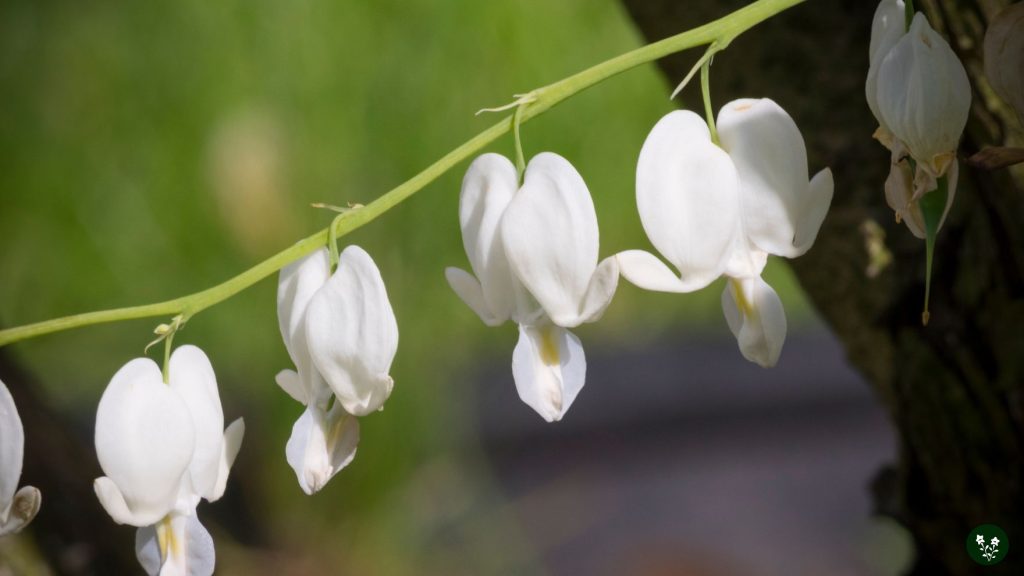
While the stunning Bleeding Heart flower has made a name for itself due to its dramatic shape and captivating color, it also offers several uses and benefits that you may find appealing.
When it comes to special occasions, adding sprigs of Bleeding Heart flowers to wedding bouquets and table decorations can create a visually striking touch to your event.
The distinctive shape of the flower pairs well with many other blooms, making it an excellent botanical addition to your celebration.
It’s not just the aesthetics that make Bleeding Hearts a desirable plant; some herbalists value the flower for its potential health benefits.
For example, tinctures made from Bleeding Heart roots have been used to alleviate nerve pain and promote general wellness.
Furthermore, this unique flower is said to help calm the nervous system, offering relief from insomnia and anxiety when utilized correctly.
While incorporating Bleeding Hearts into your garden, consider planting them alongside seeds of other shade-tolerant plants or vines for a more prosperous and diverse landscape.
This way, the beauty of Bleeding Heart flowers can further enhance your soothing outdoor space.
Before diving into these uses and benefits, always be cautious, as Bleeding Hearts are toxic to humans and pets.
Consuming any part of the plant may lead to adverse effects, such as skin irritation or severe symptoms when ingested.
Enjoy this fascinating flower’s aesthetic and potential benefits, but remember to handle it carefully.
7. Interesting Facts about Bleeding Heart Flower

Bleeding Heart Flower is a captivating perennial plant known for its unique, heart-shaped flowers that have captivated gardeners and flower enthusiasts for centuries.
Here are some interesting facts about this fascinating plant:
- Scientific name: Lamprocapnos spectabilis (formerly Dicentra spectabilis)
- Family: Papaveraceae (poppy family)
- Native to: Eastern Asia, particularly China, Korea, and Japan
- Bloom time: Spring, typically from April to June
- Flower shape: Unique heart-shaped flowers with a protruding inner petal
- Color varieties: Pink, red, white, and bicolors
- Plant height: 24-36 inches (60-90 cm)
- Plant spread: 18-30 inches (45-75 cm)
- Growing zones: USDA hardiness zones 3-9
- Soil preference: Well-draining, humus-rich, and moist soil
- Light requirements: Partial shade to full shade
- Symbolism: Love, romance, vulnerability, and the ephemeral nature of life
- Folklore: Associated with the legend of a rejected prince and a heartbroken princess
- Cultivars: ‘Alba’ (white), ‘Gold Heart’ (yellow foliage), and ‘Valentine’ (deep red flowers)
- Toxicity: Contains isoquinoline alkaloids, making it toxic to humans and pets if ingested
- Wildlife: Attracts pollinators such as bees and hummingbirds, but deer and rabbit resistant
8. What Occasions Are Bleeding Heart Flowers Commonly Gifted?
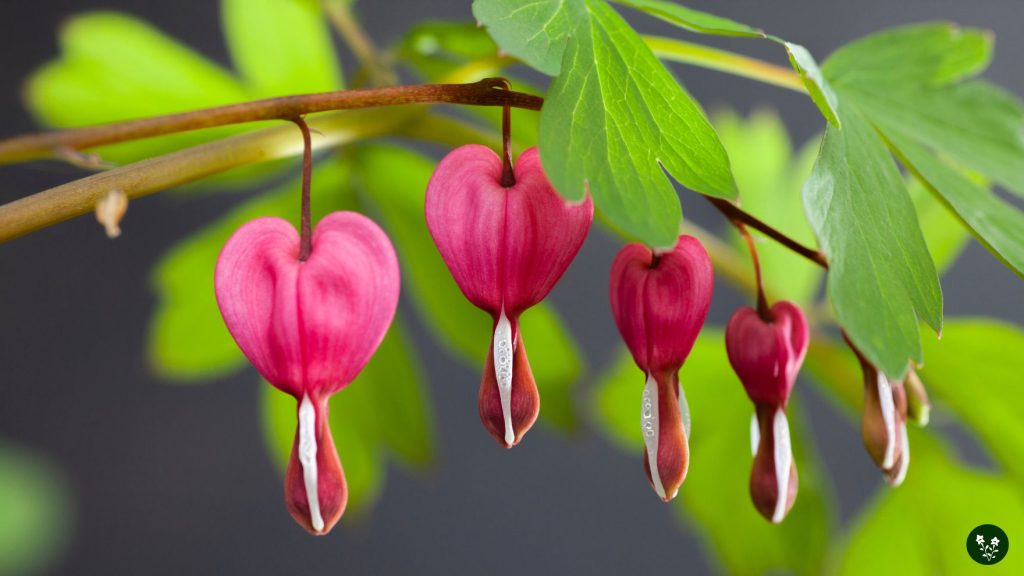
With their heartfelt symbolism, Bleeding Heart flowers are a popular choice for various special occasions.
Their strong association with passionate love, romance, and emotional sensitivity makes them an excellent choice for romantic events.
Valentine’s Day is a natural fit for gifting Bleeding Heart flowers. Their striking appearance and rich symbolism are perfect for expressing your feelings to someone you care about.
You can surprise your loved one with a bouquet or plant a Bleeding Heart in your garden as a long-lasting testament to your love.
Weddings benefit from the vivid, heart-shaped flowers of Bleeding Heart plants.
Incorporate them into your wedding bouquet and table decorations to add a touch of elegance and represent the loving bond between the bride and groom.
The pure white Bleeding Heart variety gives your decorations a sense of purity.
With strong spiritual undertones, Lent and Easter can also be the right times to arrange Bleeding Heart flowers in your home.
Symbolizing compassion and spiritual connection, these flowers offer a gentle reminder of the importance of empathy during these reflective periods.
Any romantic occasion, such as anniversaries, is a wonderful time to gift your partner a Bleeding Heart plant or flowers.
Mark each memorable milestone in your relationship with these stunning and meaningful blooms, solidifying your bond with your loved one.
Discover the hidden meanings behind your favorite flowers:
Leave a Reply